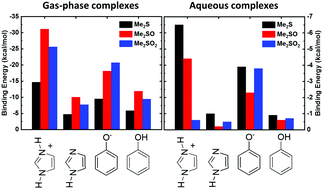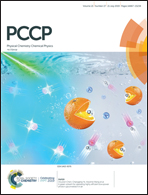Expanding the range of binding energies and oxidizability of biologically relevant S–aromatic interactions: imidazolium and phenolate binding to sulfoxide and sulfone†
Abstract
Oxidation and protonation/deprotonation strongly impact intermolecular noncovalent interactions. For example, S–aromatic interactions are stabilized up to three-fold in the gas phase on oxidation of the sulfur ligand or protonation/deprotonation of the aromatic. To probe if such stabilizing effects are additive and to model interactions of oxidized methionine (MetOn) with protonated histidine and deprotonated tyrosine residues in proteins, we examined Me2SOn (n = 1, 2) binding to imidazolium, phenolate and their 4-methylated forms. Ab initio MP2(full)/6-311++G(d,p) gas-phase calculations reveal that the Me2SOn–imidazolium complexes adopt edge-on geometry with σ-type (N/C–Har⋯O) H-bonding and interaction energies of −17.2 to −31.1 kcal mol−1. The less stable (−13.8 to −21.0 kcal mol−1) Me2SOn–phenolates possess en-face geometry stabilized by π-type (C–H⋯πar) H-bonding. Comparing these energies with those reported for the Me2S-neutral aromatics affirms the additive effects of ligand protonation/deprotonation and oxidation on gas-phase stability. However, this is not the case in water although the aqueous complexes retain their preferred gas-phase σ- and π-type H-bonded structures. Binding free energies (kcal mol−1) calculated from molecular dynamics simulations in bulk water (preceded by CHARMM36 force field calibration where necessary) reveal that Me2SO–imidazolium (−4.4) is more stable than Me2SO–phenolate (−2.4) but Me2SO2–imidazolium (−0.6) is less stable than Me2SO2–phenolate (−3.8). Vertical ionization potentials (IPV) calculated for the gas-phase complexes indicate that the Me2SOn–phenolates, but not the Me2SOn–imidazoles, are oxidizable under biological conditions. Charge transfer from the phenolate increases its IPV by ∼20%, decreasing its susceptibility to oxidation. Overall, this work provides fundamental data to predict the behaviour of protein-based MetOn–aromatic-ion interactions.

- This article is part of the themed collection: PCCP Editor’s Choice, 2020


 Please wait while we load your content...
Please wait while we load your content...